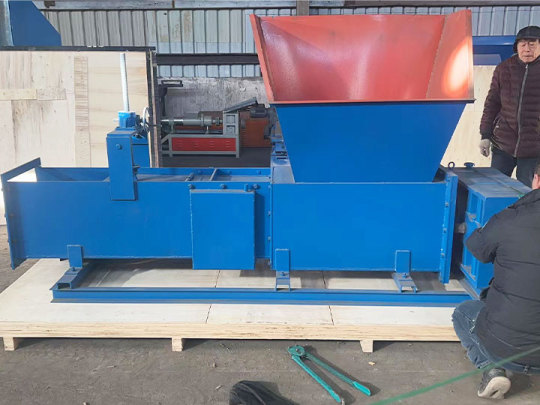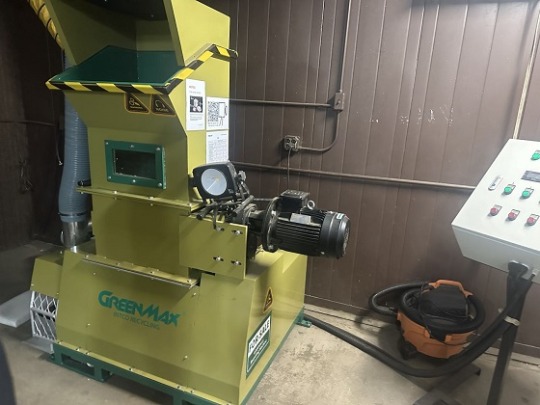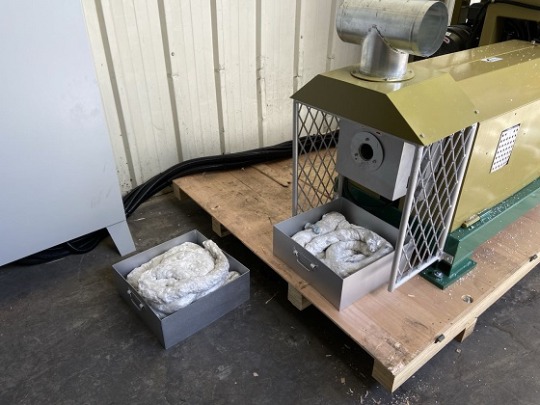#polystyrene compactor
Explore tagged Tumblr posts
Text
Revolutionizing Polyethylene Foam Recycling: GREENMAX's Cutting-Edge Solutions
Polyethylene foam (PE foam) is renowned for its flexibility, durability, and shock-absorbing properties, making it a preferred choice in packaging, construction, and various industrial applications. However, its widespread use has led to significant environmental challenges due to its non-biodegradable nature. Addressing this issue requires effective recycling strategies, and GREENMAX stands at the forefront of providing innovative solutions for PE foam recycling.

The Importance of Recycling Polyethylene Foam
PE foam's extensive use results in substantial waste generation. Improper disposal methods, such as landfilling or incineration, contribute to environmental pollution and resource wastage. Recycling PE foam not only mitigates these environmental impacts but also promotes a circular economy by converting waste into valuable resources.
youtube
GREENMAX's Advanced Recycling Technologies
GREENMAX, a division of INTCO Recycling, specializes in designing and manufacturing state-of-the-art recycling machinery tailored for various foam materials, including PE foam. Their equipment is engineered to efficiently reduce the volume of foam waste, facilitating easier storage, transportation, and reprocessing.
1. GREENMAX ZEUS Series: PE Foam Compactors
The ZEUS Series employs a combination of physical screw compression and surface melting technologies to process PE foam waste. This method effectively compresses the foam to 1/50th of its original volume, creating dense blocks that are less prone to loosening. The surface melting technique enhances the stability of the compressed material, ensuring optimal handling and transportation.
2. GREENMAX MARS Series: PE Foam Densifiers
The MARS Series utilizes thermal processing to melt PE foam waste, achieving a volume reduction ratio of up to 90:1. This process transforms the foam into dense ingots, significantly minimizing storage space requirements and transportation costs. The densified material can be further processed into pellets for manufacturing new plastic products, promoting resource reutilization.

Customized Recycling Solutions
Recognizing that different industries have unique recycling needs, GREENMAX offers customized solutions tailored to specific requirements. For instance, they have developed specialized systems for electronics manufacturers to efficiently recycle EPE foam packaging waste. These systems include features like large silos for storing crushed foam and adjustable compression functions to optimize energy consumption.
Case Study: Successful Implementation
A notable example of GREENMAX's impact is their collaboration with SEKISUI Plastics USA. Facing challenges in recycling EPO foam, SEKISUI partnered with GREENMAX to implement a customized foam recycling system. This solution integrated a foam densifier with an automatic water cooling system, achieving a high compression ratio and enabling efficient recycling operations. Since its installation, the system has processed over 50,000 pounds of foam waste, with an anticipated annual recycling volume of 600,000 pounds.
Benefits of Partnering with GREENMAX
Environmental Responsibility: Implementing GREENMAX's recycling solutions helps businesses reduce their environmental footprint by diverting PE foam waste from landfills and promoting sustainable practices. Cost Efficiency: By significantly reducing the volume of foam waste, companies can lower transportation and storage costs. Additionally, the recycled material can be sold or reused, creating potential revenue streams. Regulatory Compliance: Adopting effective recycling practices ensures compliance with environmental regulations and demonstrates corporate social responsibility.
Conclusion
As the demand for sustainable waste management solutions grows, GREENMAX continues to lead the way in polyethylene foam recycling. Their advanced machinery, customized solutions, and proven success stories position them as a trusted partner for businesses aiming to enhance their recycling capabilities and contribute to a greener future. If you are interested in our Polyethylene Foam Recycling Solution, please click here to contact us.
#recycling#greenmax#polystyrene recycling#eps recycling#foam recycling#expanded polystyrene recycling#polystyrene compactor#epe foam recycling#Youtube
1 note
·
View note
Text

Shuliy provides a foam compressor that reduces the volume of large blocks of foam by 40 times, saving storage space and greatly improving the efficiency of foam recycling.
The capacity of the foam compressor is 250 kg/h, without the need for heating or electricity consumption, and the output foam is white in color and of high quality.
If you're interested, please feel free to view our website and feel free to contact us.
📱WhatsApp/Tel/WeChat:+86 17303831295
🌐https://www.plasticgranularmachine.com/product/eps-compactor-for-resycling-eps-foam/
📧Email: [email protected]
1 note
·
View note
Video
youtube
foam compacting production line/foam compactor/foam compacting line/eps compacting production line
#youtube#epscompactor#eps compactor#foam compactor#eps foam compactor#styrofoam#foam#foam recycling#eps recycling#eps recycling machine#foam recycling machine#styrofoam recycling machine#polystyrene compactor#polystyrene foam compactor#polystyrene recycling machine#polystyrene foam recycling machine
0 notes
Text
Use a polystyrene compactor instead of a landfill and several impractical recycling techniques
Dumpster diving The earth and environment will suffer greatly from polystyrene. A typical plastic used in building, packaging, and other consumer goods including foam sheets, throwaway cups, silverware, and food containers is polystyrene. However, the long-term detrimental effects of landfilled polystyrene on ecosystems and the environment are caused by its chemical makeup and tenacity. Specific damages to soil and the ecosystem that polystyrene landfills might bring about include the following:

Both non-degradability and persistence are long-lasting. Polystyrene is a substance that is difficult for microorganisms to break down naturally. It takes a long time for them to do so. For it to fully deteriorate, hundreds or even thousands of years may pass. This implies that polystyrene that ends up in a landfill will become a persistent contaminant and stay in the ecosystem for a very long period.
Chemical release causing soil contamination Chemical additions that are harmful: Products made with polystyrene frequently include chemicals like plasticizers, flame retardants, antioxidants, etc. Over time, these compounds might leak into the soil after being liberated from the material. Pollution from heavy metals: During the landfilling process, certain polystyrene products may include heavy metals that can progressively seep into the soil and degrade soil quality.
contamination from microplastics Microplastic formation: Polystyrene has the potential to fragment into smaller pieces and turn into microplastics as it goes through the landfill process. Because they can pass through the soil layer, these microplastics can spread further and have an impact on soil organisms. Bioaccumulation: Microplastics can build up in soil organisms as a result of inadvertent consumption. This can have an impact on the growth and reproduction of the species as well as the overall health of the ecosystem.
Effect on wildlife: choking and ingestion Risk of ingestion: Wildlife may mistakenly consume discarded or landfilled polystyrene for food. Unintentional ingestion can result in mortality, poor food absorption, and obstruction of the animal's digestive tract. Fish and birds in particular, as well as other marine creatures, frequently consume polystyrene pellets.

Choking and Injuries: The structure of polystyrene can ensnare small animals or insects, leading to asphyxia or injuries.
Ecological disparity
Impact on the food chain: Polystyrene's persistence and accumulation in the environment may lead it to move up the food chain and damage a variety of biological levels, from tiny species to giant predators, which will ultimately have an impact on biodiversity and ecological equilibrium.
In actuality, there are a lot of unknown risks, so we need to take proactive measures and recycle using tools like polystyrene compactors. To stop waste from entering the environment and to ensure prompt recycling, first compress the waste polystyrene. The most crucial thing is this. Compressing the expanded polystyrene's volume in order to reduce its volume is the primary purpose of the Polystyrene Compactor. The recycling of polystyrene will already be half successful once this issue is resolved.
0 notes
Text
0 notes
Text
https://www.siedontech.com/how-to-recycle-eps-xps-foam-waste-by-foam-compactor.html
Benefits Of Recycling XPS And EPS Waste
The huge reduction in polystyrene waste is one of the important benefits of recycling, which is easy to transport and shop. Recycling is most likely to help reduce landfill pollution and pose a serious threat to both the environment and animal survival.At the same time, recycling reduces the need for entirely new products, thereby reducing energy and worker expenses
In addition to effectively managing polystyrene waste, recycling EPS and XPS waste is the most effective way for services to reduce their carbon footprint. At present, the main recycling service is to minimize the waste of foam by the foam compactor, press it into granules, and then process it into finished products for sale, so that waste materials that once cost money to dispose of can become profitable products.
0 notes
Text
Styrofoam Compactor | Polystyrene Cold Compactor | Cold Pressing Equipment | Qinfeng Machinery
Cellphone/Whatsapp: 0086-13584429220 Web: https://www.qinfeng-epsmachine.com/ Email:[email protected]
0 notes
Text
GREENMAX Polystyrene Compactor turns waste polystyrene into new frame products
Nowadays, waste management in various countries is becoming more and more strict. China has introduced a ban on the import of plastic waste, and other countries have to find new ways to deal with their waste plastics.
Many industries have begun to use polystyrene compactor to manage the increasing amount of plastic foam waste. The main purpose of recycling is to protect the environment, and recycled polystyrene material can be reused to make new foam products and reduce additional waste that could be harmful to the environment.
Polystyrene compactor is specially designed to dispose of plastic foam waste, which helps to recycle large amounts of waste materials, include plastic bottles, large polystyrene packaging, and other plastic parts. The polystyrene compactor can easily recycle waste into smaller pieces and the polystyrene waste will no longer end up in landfills. In addition, the process reduces soil and air pollution while helping to protect resources.
Without recycling, polystyrene becomes nothing but waste, it will finally end up in landfills along with other waste. Polystyrene, which does not decompose for a long time, also causes serious pollution to the environment. But recycling makes a big difference. The recycled polystyrene materials, as the renewable raw material, can be used to make new polystyrene products.

INTCO recycling offers you total solutions for polystyrene recycling. The company not only provides high-quality polystyrene compactors but also purchases the compacted foam blocks back to make frames produces. INTCO’s frame products made of recycled polystyrene are popular because of their environmental friendliness.
0 notes
Text
Polystyrene Compactor Can Help Your Foam Recycling Action
If you are an environmentalist, or the polystyrene recycling enthusiast, then the polystyrene Compactor will truly be of interest to you. its magic is that it can turn a huge loose polystyrene into a compacted, small-volume foam block, which, turns out to be the essence of polystyrene recycling. Such a compactor is necessary and after all, polystyrene cannot be recycled from your kerbside recycling bin.

The principle of polystyrene compactor is simple as it depends on simple parameter settings on the screen, reliable and simple operation, responsive action and controllable time, multiple alerts and protection. Through the crusher the polystyrene will be crushed into small pieces and then compressed by the screw, finally in the output chute the pieces will form a solid block.
0 notes
Text
Why EPS Recycling Is So Important?
The need for society to accept recycling and reduce waste EPS is greater than ever before as the globe facing a broadening array of environmental problems. As GREENMAX continues to innovate EPS recycling solutions, we are rapidly increasing EPS recycling rates across Australia.
In 2023 alone, we buyback recycled EPS foam as much as 2,572 tonnes of expanded polystyrene waste away from landfills, saving as high as 11,450 tonnes of carbon dioxide (CO2) discharges at the same time. Nevertheless, this is only a part of what we have actually achieved. The real number is substantially higher since, with the assistance of our many recycling companions, we make it feasible for huge commercial quantities of EPS to be recycled.
These kinds of figures highlight progress being made and the concrete benefits of EPS recycling, which is why we continue to upgrade our EPS recycling machines to serve more companies and councils in Australia that have EPS recycling needs.

EPS Recycling Reduces Emissions
The 11,450 tonnes of carbon dioxide exhausts that GREENMAX managed to save via EPS foam packaging alone highlight the environmental significance of recycling this material.
Additionally, we can help in reducing emissions by converting customer EPS foam packaging waste right into raw materials for products like extruded polystyrene (XPS) sheets, a useful insulation material for under piece and perimeter-edge insulation in energy-efficient buildings. This contributes to mitigating climate change due to the fact that fewer emissions are produced through recycling than with the manufacturing of virgin materials. Likewise, insulation leads to lower total energy consumption.

EPS Recycling Reduces Land Fill Waste
We ought to make an initiative to use landfills as little as feasible because they are a finite source and an affliction on the environment. As a result of its slow disintegration rate, non-recycled EPS can cause overfilling and environmental damages.
By recycling expanded polystyrene, we can offer a viable service to reducing the burden on landfills. As more and more companies and councils choose GREENMAX, we believe that the collective result of drawing away expanded polystyrene and waste will play a key role in assisting to make certain a more sustainable waste management system in Australia.

EPS Recycling Promotes A Circular Economic
EPS Recycling by granulating it and converting it back into resources allows us to create a closed-loop system that not just reduces demand for virgin materials yet also creates work with a responsible and circular approach.
These recycled materials can after that be used to produce insulation materials that contribute to a reduction in energy expenditure, leading to businesses and customers alike coming to be important players in the combat against climate change and helping with a far more sustainable supply chain.
Entirely, this contributes to a healthier environment and a sustainable economy. To become partner of GREENMAX to recycle EPS foam, contact us today and be a part of the solution!
#recycling#greenmax#polystyrene recycling#eps recycling#foam recycling#expanded polystyrene recycling#plastic recycling#polystyrene compactor
1 note
·
View note
Text
Can't Solve Large Foams? Look at our EPS Compactor
Shuliy provides a foam compressor that reduces the volume of large blocks of foam by 40 times, saving storage space and greatly improving the efficiency of foam recycling.
The capacity of the foam compressor is 250 kg/h, without the need for heating or electricity consumption, and the output foam is white in color and of high quality.
If you're interested, please feel free to view our website and feel free to contact us.
📱WhatsApp/Tel/WeChat:+86 17303831295
🌐https://www.plasticgranularmachine.com/product/eps-compactor-for-resycling-eps-foam/
📧Email: [email protected]
1 note
·
View note
Video
youtube
compaction system for EPS packaging, eps fish boxes
#youtube#eps compaction#eps compactor#styrofoam compactor#polystyrene compactor#eps recycling machine#eps recycling#styrofoam recycling#polystyrene recycling#foam recycling#eps foam recycling machine#eps foam recycling#styrofoam recycling machine#polystyrene recycling machine#polystyrene foam#foam recycling machine
0 notes
Text
A Styrofoam compactor can simultaneously address the issue of numerous foams contributing to white pollution.
Styrofoam is widely employed in numerous industries in modern civilization. But there are significant environmental risks associated with this material's convenience. Styrofoam use and disposal have resulted in numerous environmental issues as a solution to this dilemma.

1. Difficult to decompose: Foam plastic is not easily broken down by nature. It can take hundreds of years for Styrofoam to entirely break down in the natural world.
2. Space taken up: Foam plastic trash occupies a large amount of landfill space because of its mass and low density, which exacerbates waste disposal issues.
3. Visual pollution: Dispersed Styrofoam plastics in the environment can injure plants and animals in addition to detracting from their look. For instance, eating Styrofoam by accident by wild animals might result in mortality or blockage of the digestive tract.
4. Microplastic pollution: As foam plastics break down into smaller pieces over time, they contribute to microplastic pollution, which contaminates waterways and food chains and endangers both human health and ecosystems.
One way to prevent this type of pollution from entering the ecosystem is to recycle it as soon as you can. A kind of machinery designed specifically for processing and recycling foam plastics is the styrofoam compactor. By stowing free Styrofoam into high-density blocks, it facilitates more inexpensive and efficient transportation and reuse scenarios. One well-known recycling technique for foam plastics is the use of styrofoam compactors. The GREENMAX styrofoam compactor has a 50:1 compression ratio and can handle a variety of materials, including extruded polystyrene, polyethylene foam, polypropylene foam, and extruded Polystyrene.

Using a styrofoam compactor is a noteworthy environmental move. Begin with yourself, begin with sorting your trash, take an active role in foam plastic recycling, and help create a cleaner, healthier world.
0 notes
Video
CF-CP250 Polystyrene compactor with Meter counter
0 notes
Video
youtube
CF-CP250 EPS cold compactor with100 kg/h capacity
0 notes
Video
youtube
CF HM50 EPS hot melting machinery small capacity 15kg per hour from Qinf...
#EPS hot melting machinery#eps compactor#small eps compactor#polystyrene compactor#styrenefoam compactor
0 notes